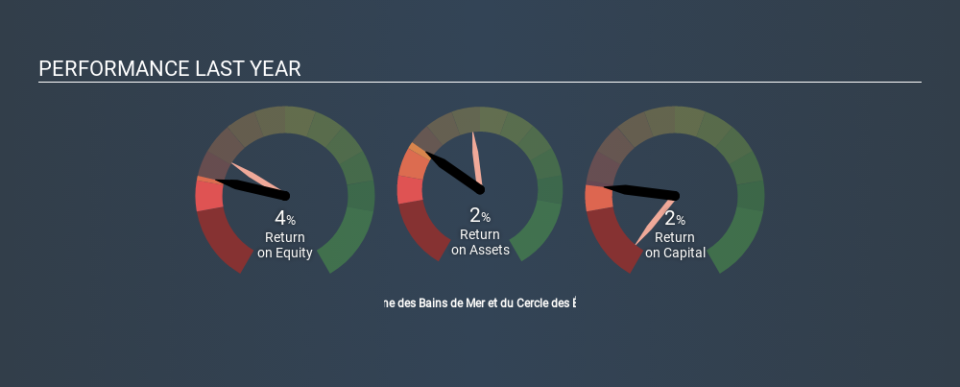Why Société Anonyme des Bains de Mer et du Cercle des Étrangers à Monaco’s (EPA:BAIN) Return On Capital Employed Might Be A Concern

Today we'll evaluate Société Anonyme des Bains de Mer et du Cercle des Étrangers à Monaco (EPA:BAIN) to determine whether it could have potential as an investment idea. To be precise, we'll consider its Return On Capital Employed (ROCE), as that will inform our view of the quality of the business.
First of all, we'll work out how to calculate ROCE. Second, we'll look at its ROCE compared to similar companies. Then we'll determine how its current liabilities are affecting its ROCE.
What is Return On Capital Employed (ROCE)?
ROCE measures the 'return' (pre-tax profit) a company generates from capital employed in its business. All else being equal, a better business will have a higher ROCE. Overall, it is a valuable metric that has its flaws. Author Edwin Whiting says to be careful when comparing the ROCE of different businesses, since 'No two businesses are exactly alike.
How Do You Calculate Return On Capital Employed?
The formula for calculating the return on capital employed is:
Return on Capital Employed = Earnings Before Interest and Tax (EBIT) ÷ (Total Assets - Current Liabilities)
Or for Société Anonyme des Bains de Mer et du Cercle des Étrangers à Monaco:
0.021 = €24m ÷ (€1.5b - €300m) (Based on the trailing twelve months to September 2019.)
Therefore, Société Anonyme des Bains de Mer et du Cercle des Étrangers à Monaco has an ROCE of 2.1%.
View our latest analysis for Société Anonyme des Bains de Mer et du Cercle des Étrangers à Monaco
Is Société Anonyme des Bains de Mer et du Cercle des Étrangers à Monaco's ROCE Good?
One way to assess ROCE is to compare similar companies. Using our data, Société Anonyme des Bains de Mer et du Cercle des Étrangers à Monaco's ROCE appears to be significantly below the 6.6% average in the Hospitality industry. This could be seen as a negative, as it suggests some competitors may be employing their capital more efficiently. Regardless of how Société Anonyme des Bains de Mer et du Cercle des Étrangers à Monaco stacks up against its industry, its ROCE in absolute terms is quite low (especially compared to a bank account). It is likely that there are more attractive prospects out there.
Société Anonyme des Bains de Mer et du Cercle des Étrangers à Monaco reported an ROCE of 2.1% -- better than 3 years ago, when the company didn't make a profit. That implies the business has been improving. The image below shows how Société Anonyme des Bains de Mer et du Cercle des Étrangers à Monaco's ROCE compares to its industry, and you can click it to see more detail on its past growth.
Remember that this metric is backwards looking - it shows what has happened in the past, and does not accurately predict the future. Companies in cyclical industries can be difficult to understand using ROCE, as returns typically look high during boom times, and low during busts. This is because ROCE only looks at one year, instead of considering returns across a whole cycle. If Société Anonyme des Bains de Mer et du Cercle des Étrangers à Monaco is cyclical, it could make sense to check out this free graph of past earnings, revenue and cash flow.
What Are Current Liabilities, And How Do They Affect Société Anonyme des Bains de Mer et du Cercle des Étrangers à Monaco's ROCE?
Current liabilities include invoices, such as supplier payments, short-term debt, or a tax bill, that need to be paid within 12 months. The ROCE equation subtracts current liabilities from capital employed, so a company with a lot of current liabilities appears to have less capital employed, and a higher ROCE than otherwise. To check the impact of this, we calculate if a company has high current liabilities relative to its total assets.
Société Anonyme des Bains de Mer et du Cercle des Étrangers à Monaco has current liabilities of €300m and total assets of €1.5b. Therefore its current liabilities are equivalent to approximately 21% of its total assets. This is not a high level of current liabilities, which would not boost the ROCE by much.
What We Can Learn From Société Anonyme des Bains de Mer et du Cercle des Étrangers à Monaco's ROCE
That's not a bad thing, however Société Anonyme des Bains de Mer et du Cercle des Étrangers à Monaco has a weak ROCE and may not be an attractive investment. You might be able to find a better investment than Société Anonyme des Bains de Mer et du Cercle des Étrangers à Monaco. If you want a selection of possible winners, check out this free list of interesting companies that trade on a P/E below 20 (but have proven they can grow earnings).
If you are like me, then you will not want to miss this free list of growing companies that insiders are buying.
If you spot an error that warrants correction, please contact the editor at editorial-team@simplywallst.com. This article by Simply Wall St is general in nature. It does not constitute a recommendation to buy or sell any stock, and does not take account of your objectives, or your financial situation. Simply Wall St has no position in the stocks mentioned.
We aim to bring you long-term focused research analysis driven by fundamental data. Note that our analysis may not factor in the latest price-sensitive company announcements or qualitative material. Thank you for reading.

 Yahoo Finance
Yahoo Finance 
